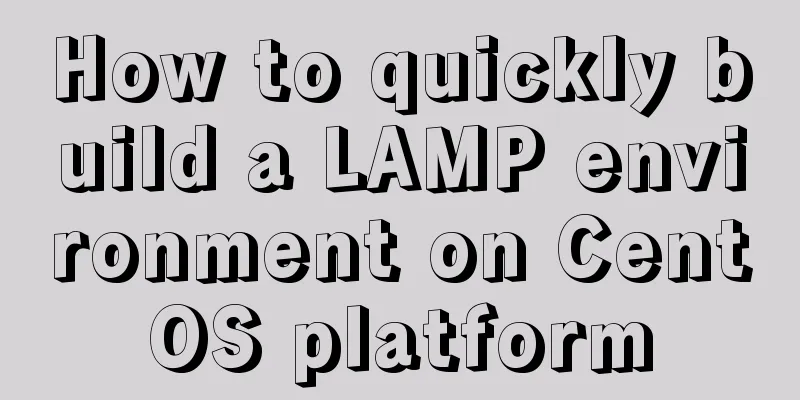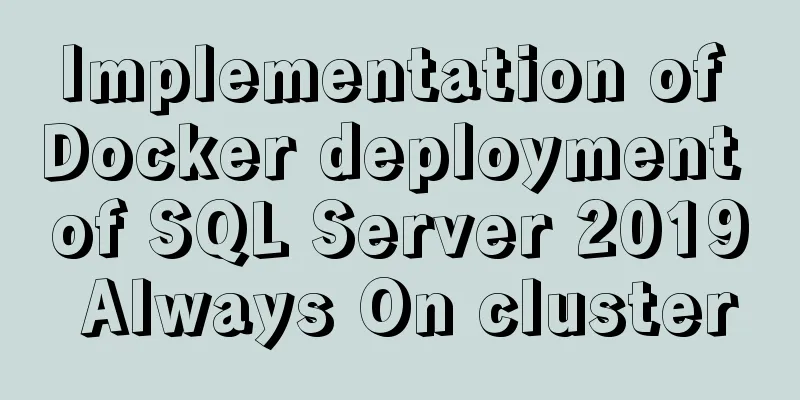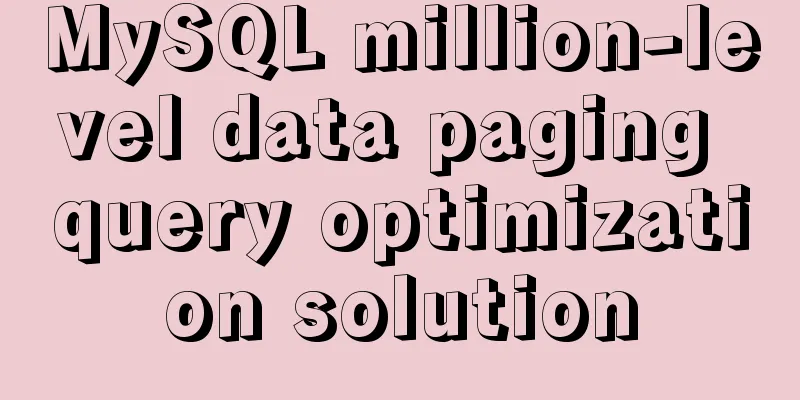Tutorial on installing mysql8 on linux centos7

|
1. RPM version installation Check if there are other versions of the database, if so, delete them cleanly Non-root users must have sudo privileges 1. Download MySQL related installation package https://mirrors.tuna.tsinghua.edu.cn/mysql/yum/mysql80-community-el7/mysql-community-server-8.0.18-1.el7.x86_64.rpm https://mirrors.tuna.tsinghua.edu.cn/mysql/yum/mysql80-community-el7/mysql-community-libs-8.0.18-1.el7.x86_64.rpm https://mirrors.tuna.tsinghua.edu.cn/mysql/yum/mysql80-community-el7/mysql-community-common-8.0.18-1.el7.x86_64.rpm https://mirrors.tuna.tsinghua.edu.cn/mysql/yum/mysql80-community-el7/mysql-community-client-8.0.18-1.el7.x86_64.rpm 2. Other dependencies (you can skip this step and install the dependencies you need to see when you install MySQL later) Go to this website to find gcc, gcc-c++, openssl, perl and their dependent packages https://mirrors.tuna.tsinghua.edu.cn/centos/7/os/x86_64/Packages/ 3. Install MySQL (if no error is reported, the installation is successful)
4. Customize MySQL configuration (if you do not want to change the default MySQL related directory, skip to step 6) Modify the default configuration file content of Mysql Delete all content and add the following: [mysqld] user=mysql port=3306 datadir=/app/mysql/data socket=/app/mysql/mysql.sock log-error=/app/mysql/log/mysqld.log pid-file=/app/mysql/mysqld.pid [client] socket=/app/mysql/mysql.sock 5. Create relevant directories in the configuration file and modify permissions sudo mkdir /app/mysql/data /app/mysql/log -p sudo chown mysql:mysql /app/mysql -R 6. Initialize mysql
7. Start mysql If startup fails: a. Check whether the user and group of the mysql related directory are mysql b. Check whether selinux is turned off: execute sudo getenforce. If the result is not Permissive, execute the command: sudo setenforce 0 c. Check whether the port is occupied d. If it still cannot start: check the mysql error log and sudo systemctl status mysqld or journalctl -xe
8. Log in to mysql Check the initial password of Mysql (root@localhost: the following is the initial password) sudo cat /app/mysql/log |grep root@localhost (used this command in step 4) sudo cat /var/log/mysqld.log|grep root@localhost (this command has not been used in step 4) Log in to mysql and copy the password above 9. Change the mysql password (the password must be changed for the first login, otherwise the mysql command cannot be used) alter user 'root'@'localhost' identified by 'your password'; 2. Source code installation Non-root users must have sudo privileges 1. Download the relevant source code package https://mirrors.tuna.tsinghua.edu.cn/gnu/gcc/gcc-9.2.0/gcc-9.2.0.tar.gz 2. Install lower versions of gcc and gcc-c++ (must be done, otherwise configure will report an error when upgrading gcc and installing m4/gmp/mpfr/mpc: configure: error: no acceptable C compiler found in $PATH) Go to this website and search for gcc, gcc-c++ and their dependent packages (if you can connect to the Internet, you can directly use the command: sudo yum -y install gcc gcc-c++) 3. Install the source version of cmake You must install openssl and openssl-devel dependencies, the download URL is the same as above, otherwise bootstrap will report an error: openssl cannot be found (if you can connect to the external network, you can directly use the command: sudo yum -y install openssl openssl-devel) tar cmake-3.16.1.tgz cd cmake-3.16.1 sudo ./bootstrap sudo make sudo make check sudo make install 4. Upgrade gcc and gcc-c++ a. Install m4 tar -xzvf m4-latest.tar.gz cd m4-1.4.17/ sudo ./configure --prefix=/usr/local (--prefix specifies the installation path) sudo make (compile) sudo make check (check if there are any errors in the compilation, pay attention to whether there are any Errors, you can skip this step) sudo make install (Installation) m4 --version (check m4 version) After correct installation, you can see the following results
b. Install gmp sudo ln -s /usr/local/bin/m4 /usr/bin (Make a soft link of m4 to this path, otherwise configure will report an error: checking for suitable m4... configure: error: No usable m4 in $PATH or /usr/5bin (see config.log for reasons).) tar -xvf gmp-6.2.0.tar.xz cd gmp-6.2.0 sudo ./configure --prefix=/usr/local/gmp-6.2 (non-administrators must use sudo, otherwise an error will be reported: Permission denied) sudo make sudo make check sudo make install c. Install mpfr tar -xzvf mpfr-4.0.2.tar.gz cd mpfr-4.0.2 sudo ./configure --prefix=/usr/local/mpfr-4.0 --with-gmp=/usr/local/gmp-6.2 (--with-gmp is the installation directory of gmp) sudo make sudo make check sudo make install d. Install mpc tar -xzvf mpc-1.1.0.tar.gz cd-mpc-1.1 sudo ./configure --prefix=/usr/local/mpc-1.1 --with-gmp=/usr/local/gmp-6.2 --with-mpfr=/usr/local/mpfr-4.0 sudo make sduo make check sudo make install e. Add library files (/usr/local/mpfr-4.0/lib/ must be added, the other two can be omitted, otherwise an error will be reported when installing and upgrading gcc compilation: error while loading shared libraries: libmpfr.so.6: cannot open shared object file: No such file or directory) sudo vi /etc/ld.so.conf /usr/local/mpfr-4.0/lib/ /usr/local/gmp-6.2/lib /usr/local/mpc-1.1/lib sudo ldconfig (make the above operation effective) Or make a soft connection sudo ln -s /usr/local/mpfr-4.0/lib/libmpfr.so.6 /usr/bin Or copy sudo cp /usr/local/mpfr-4.0/lib/libmpfr.so.6 /usr/bin/ f. Install other dependencies (if the system does not have the dependency package installed, it must be installed, otherwise an error will be reported when upgrading gcc compilation: mpc.h: no such file or directory) Download gmp-devel and libmpc-devel and their dependent packages (if you can connect to the Internet, you can directly use the command: sudo yum -y install gmp-devel libmpc-devel) https://mirrors.tuna.tsinghua.edu.cn/centos/7/os/x86_64/Packages/gmp-6.0.0-15.el7.x86_64.rpm If there are other dependent packages to download, please go to https://mirrors.tuna.tsinghua.edu.cn to download them yourself g. Upgrade gcc tar -xzvf gcc-9.2.0.tar.gz cd gcc-9.2.0 sudo ./configure --prefix=/usr/local/gcc-9.2 \ --enable-bootstrap\ --enable-checking=release \ --enable-languages=c,c++ \ --enable-threads=posix \ --disable-checking\ --disable-multilib\ --enable--long-long\ --with-gmp=/usr/local/gmp-6.2\ --with-mpfr=/usr/local/mpfr-4.0\ --with-mpc=/usr/local/mpc-1.1 sudo make (compilation time is long, about 1 hour) sudo make check sudo make install Be sure to uninstall the lower version of gcc and gcc-c++ sudo rpm -e gcc-c++ sudo rpm -e gcc sudo vi /etc/profile export PATH=$PATH:/usr/local/gcc/bin source /etc/profile Check the gcc version number 5. Install the source version of MySQL Install ncurses-devel dependency, otherwise cmake will report an error: Curses library not found. Please install appropriate package (If you can connect to the Internet, you can directly use the command: tar -xzvf mysql-8.0.19.tar.gz cd mysql-8.0.19 cmake . -DCMAKE_INSTALL_PREFIX=/app/mysql\ -DDEFAULT_CHARSET=utf8\ -DDEFAULT_COLLATION=utf8_general_ci\ -DENABLED_LOCAL_INFILE=ON\ -DWITH_SSL=system\ -DMYSQL_DATADIR=/app/mysql/data\ -DSYSCONFDIR=/app/mysql/config\ -DMYSQL_TCP_PORT=3306\ -DMYSQL_UNIX_ADDR=/app/mysql/mysql.sock\ -DWITH_BOOST=/home/mcbadm/mysql8/\ -DFORCE_INSOURCE_BUILD=1 The above parameters are introduced as follows (simple parameters, for more detailed parameters, please refer to https://blog.51cto.com/laowafang/1294964): -DCMAKE_INSTALL_PREFIX: installation directory -DDEFAULT_CHARSET: Set character set -DDEFAULT_COLLATION: Set collation -DENABLED_LOCAL_INFILE=ON: Enable local data import support -DWITH_SSL=system: Enable SSL library support -DMYSQL_DATADIR: Data file directory, any -DSYSCONFDIR: Configuration file directory, any -DMYSQL_TCP_PORT: TCP port that mysql listens on -DMYSQL_UNIX_ADDR: mysql.sock path, any -DWITH_BOOST: Boost source package directory -DFORCE_INSOURCE_BUILD: Force creation of non-existent resource directory If cmake reports an error, find the cause and solve it, delete CMakeCache.txt and cmake again sudo rm -rf /usr/lib64/libstdc++.so.6* (delete all lower version c++ library files) sudo ln -s /usr/local/gcc-9.2/lib64 /usr/lib64 (add the newly installed high-end C++ library file to the system library file) sudo make (takes about 1 hour) sudo make install 6. Write configuration files, create directories and authorize sudo mkdir /app/mysql/config sudo cd /app/mysql sudo vi config/my.cnf Add the following: [mysqld] user=mysql port=3306 datadir=/app/mysql/data socket=/app/mysql/mysql.sock [mysqld_safe] log-error=/app/mysql/logs/mysql-err.log pid-file=/app/mysql/mysql.pid [client] socket=/app/mysql/mysql.sock sudo useradd mysql -s /sbin/nologin sudo mkdir -p /app/mysql/logs sudo touch /app/mysql/logs/mysql-err.log sudo chown -R mysql.mysql /app/mysql 7. Initialize and log in to change password initialization sudo /app/mysql/bin/mysqld --initialize-insecure --user=mysql --datadir=/app/mysql/data --basedir=/app/mysql (no initial password, if you want an initial password, use --initialize) start up Log in (if there is no initial password, just press Enter) Change Password Summarize The above is the tutorial on how to install mysql8 on linux centos7 introduced by the editor. I hope it will be helpful to everyone! You may also be interested in:
|
<<: Detailed explanation of the process of installing msf on Linux system
>>: WiFi Development | Introduction to WiFi Wireless Technology
Recommend
Detailed explanation of docker version es, milvus, minio startup commands
1. es startup command: docker run -itd -e TAKE_FI...
Learn SQL query execution order from scratch
The SQL query statement execution order is as fol...
CSS achieves highly adaptive full screen
When writing my own demo, I want to use display:f...
Solution to the problem that mixin does not work in scss (browser cannot compile it)
Mixin method: The browser cannot compile: The old...
Example code for implementing a three-column layout with CSS, where the middle column is adaptive and changes width with text size
The questions encountered in Baidu interviews nee...
How to install JDK8 on Windows
1. Download: http://www.oracle.com/technetwork/ja...
InnoDB engine redo file maintenance method
If you want to adjust the size and number of Inno...
Detailed explanation of chmod command usage in Linux
chmod Command Syntax This is the correct syntax w...
Discussion on horizontal and vertical centering of elements in HTML
When we design a page, we often need to center th...
MySQL 8.0.18 Installation Configuration Optimization Tutorial
Mysql installation, configuration, and optimizati...
Web Design Experience: 5 Excellent Web Design Concepts Full Analysis (Pictures)
Unlike other types of design, web design has been ...
Concat() of combined fields in MySQL
Table of contents 1. Introduction 2. Main text 2....
Solve the problem that Navicat cannot connect to the MySQL server in the Centos system in VMware
Solution to Host 'xxxx' is not allowed to...
How to configure nginx to limit the access frequency of the same IP
1. Add the following code to http{} in nginx.conf...
MySQL Series 12 Backup and Recovery
Table of contents Tutorial Series 1. Backup strat...













